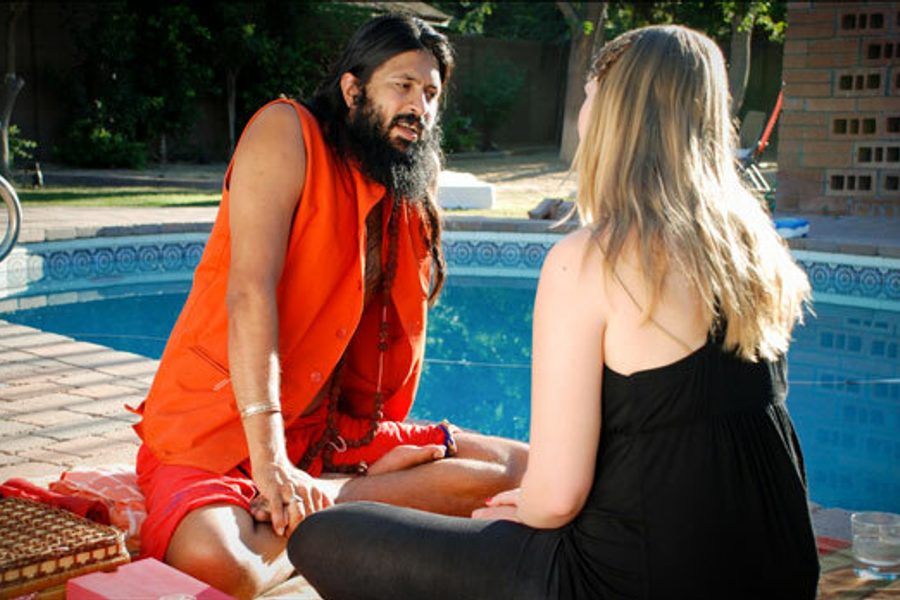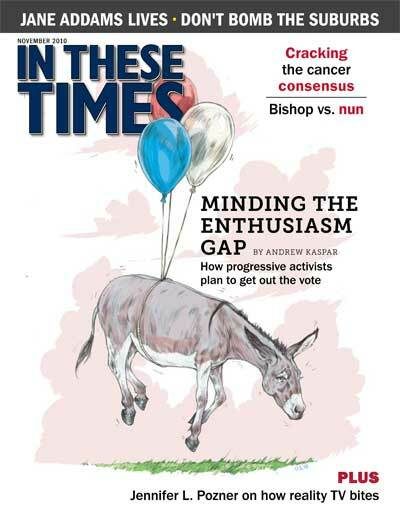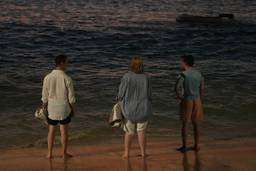Reading Gandhi in Budrus
A new documentary illuminates the power of nonviolent protest in a Palestinian village opposing the West Bank barrier.
Michael Atkinson

The Israeli-Palestinian problem has been unfurling for so many decades now, with a steady undulation between periods of tense face-off and outbreaks of violence, that any observer is likely to vacillate between despair and bitter cynicism. Especially in light of Obama’s recent shot at peace talks, compassion fatigue is bound to set in, and it’s easy to decide that the conflict is unresolvable and humankind is just a breed of warring dogs.
The movies we see emerging out of the zone, fiction and documentary, far too often take up the Rodney King mantra – “can’t we all get along?” – claiming an equitable middle ground that does not, in fact, exist. Under the circumstances, you can almost feel the aching desire for a simplistic playground solution, when all there can be is arduous process accompanied by ceaseless bloodshed.
For active participants, of course, philosophical surrender of any kind is not an option, whether they’re Israeli politicians and soldiers using the latest ordinance to hold onto the ground they’ve taken or Palestinian civilians trying to regain their sovereignty as the tanks roll, the American fighter jets strafe and the West Bank barrier goes up.
The conflict continues, diplomatically as well as on the ground, where, in response to the wall, everyday Palestinians are choosing nonviolent action in the manner of Gandhi and Martin Luther King. In the new film Budrus we see this rise in awareness and resolve in action: Led by patient, quiet longtime community organizer and local family man Ayed Morrar, the titular village commits to a protest regimen of nonviolence in 2004 and 2005, as the soldiers and bulldozers move in. The initial plan for the wall, illustrated clearly in Julia Bacha’s film, is a nightmarish thicket of curlicues and obstructions set entirely on and indeed taking up huge chunks of Palestinian land. Worse, its path would cut villages in two, separate families, and in the case of Budrus, prevent the agricultural town from accessing its own farmland and olive groves, which sustain the community.
What happened next surprised even Morrar, though it seemed to be largely his doing: The protests turned back the Israelis for a time and continued to plague them peacefully for months, even as old women were beaten with rubber batons (Bacha has this and more on film) and olive trees were uprooted. In the meantime, Morrar trained international attention on the protests, securing a visit from Palestinian National Authority Prime Minister Salam Fayyad and coverage on Al Jazeera, and inviting not only global activists to join them, but Israeli activists as well. It’s the latter that seem to have proven decisive: Jews angrily facing down Jews on the Palestinian hillsides raised the publicity stakes for the army, and the more live bullets they fired once the nonviolence pact devolved into spurts of brick-throwing, and the more Jews they arrested, the more visible the confrontation became on the world stage.
Obviously the entire 10-month-long debacle was an embarrassment for Israel, as it should have been. Bacha’s tone is reserved – she lets Morrar and the residents of Budrus, and one lovely Israeli field commander, tell the truth, and lets the dynamic of resistance vs. militaristic oppression, playing out in the olive fields, speak for itself.
She’s got a fascinating figure in Morrar – he’s not a charismatic movie persona, but rather, and more important, a truly heroic ordinary man: patient, insistent, calm and principled. Morrar is the kind of man who pursues collective social progress rather than headlines or offices. He is the governor or congressman we wish we all had but never do.
In the end, the political thrust of Budrus is unequivocal, and not much truck is to be had with excuses for Israeli’s long occupation and subjugation of the Palestinians. The publicity tagline for the film declares “It takes a village to unite the most divided people on Earth,” but despite the help Budrus receives, this is not a tale of unification but of a state of siege and stalwart defiance. Still, Bacha makes a point out of Morrar’s hatred for Hamas’ rhetoric and positions, and yet he accepts them as an integral part of Palestinian life, forming his ad hoc coalition in the same spirit that must prevail over the entire political spectrum. It’s such a rare yet familiar paradigm – a man of pragmatic and humane common sense coming across as a visionary.
Clearly, given a degree of organization, the Palestinians could alter the climate in their favor with Morrar’s strategies – if the collective will, in a people atomized and delegitimized by force, could be mustered.
SPECIAL DEAL: Subscribe to our award-winning print magazine, a publication Bernie Sanders calls "unapologetically on the side of social and economic justice," for just $1 an issue! That means you'll get 10 issues a year for $9.95.








